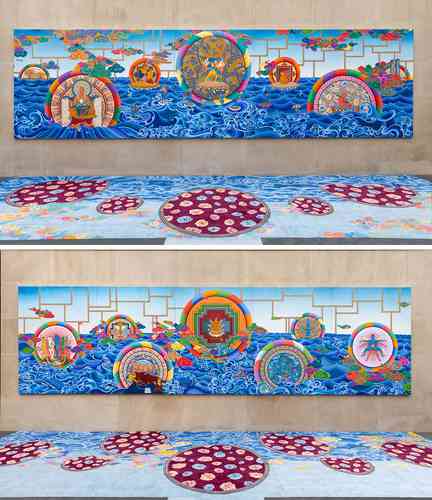A mandala of our time coexists at the Met with the ancient iconography of Tibet
▲ Installation Biography of a thought, by the artist Tenzing Rigdol, who is part of the exhibition Mandalas: Mapping the Buddhist art of Tibetwhich is exhibited at the Metropolitan Museum of Art (Met) in New York.Photo courtesy of the Met
The artist Tenzing Rigdol created a mandala of our time
for the Metropolitan Museum of Art (Met) in New York, which is exhibited alongside ancient diagrams of the universe made in Tibet eight centuries ago. A Buddha connected to cell phones, the faces of Julian Assange and George Floyd are captured in the colorful diagram to express the current conflicts that confront Buddhist wisdom.
Now is the time to limit your thinking. Just take a seat. calm down
recommends the creator of Nepalese origin, who in his work interweaves traditional Buddhist iconography with contemporary elements to address his own diaspora history.
unstable minds
The installation Biography of a thoughtcreated by Rigdol, in addition to expressing central ideas of tantra, interprets the world created by unstable minds and how conflicts arise.
There you have the bombing of Hiroshima and Nagasaki, one of the most shocking events in world history, and the Twin Towers. When I was doing the sketch, the George Floyd incident occurred; all this anger, frustration. And then there is the very sad, especially in the United States, gun violence of children
says Rigdol in an interview published by the Met to describe elements observed in his recent work available to the public until January 2025.
“I thought it would be interesting to include these whistleblowers: Haugen, Manning, Snowden, Assange, individuals who are telling us: ‘these things are happening,’ but this attention is drained from our system by the excessive use of technology, like iPhones .”
The Met inaugurated the exhibition on September 19 Mandalas: Mapping the Buddhist art of Tibet, a dazzling visual experience that provides a roadmap to understanding Himalayan Buddhist worship through its early masterpieces
.
Universe diagrams
A mandala is an intricate diagram of the universe, a map of true reality used to teach the path to enlightenment in Buddhist practice
explains this exhibition in one of the most famous and visited museums in the world.
Tempera paints, color pigments and gold printed on cotton and palm leaves make up some of the pieces placed for public viewing in the Big Apple. More than 100 paintings, sculptures, textiles, musical instruments and ritual objects, most dated between the 12th and 15th centuries, are the means to explore the Buddhist devotional art of the Himalayas.
The selection shown comes from the Met’s collection, as well as loans from private and public collections, including two very old Tibetan mandalas, exquisite
illustrated manuscripts of Prajnaparamita and Gandavyuha on palm leaves, along with important monastic portraits from the 12th to 14th centuries, including those of Atisha and Shakyashri Bhadra, two Indian monks who helped bring Buddhist teachings to Tibet, and the loan of a pair of gem-like portraits of the founders of Taklung Monastery.
The museum noted in its official statement that each room addressed an important aspect of Tibet’s artistic production: masters who interpreted esoteric texts and established monastic lineages, bodhittavas who help on the spiritual path of devotees, protectors who rid the world of evil and care for Buddhist teachings and tantric deities as evocations of enlightenment. The last thematic core contains a group of seminal works of mandalas and complex diagrams that integrate deities and iconography shown in the previous rooms.
Tanzing was commissioned to create contemporary works displayed in an atrium in juxtaposition with Asian relics. The 42-year-old artist created four monumental panels that surround the room, an area that It felt very spiritual.
hexagonal in shape and with the light from the sky passing through the stained glass of the ceiling. The decorated rugs invite you to sit, contemplate and calm the mind. It almost seemed like the space itself could be a mandala
he maintains in a video released by the Met.
In one of the tantric texts Padmasambhava, a founding teacher of Buddhism in Tibet, said that one’s nature is like a fish that jumps out of the ocean and sees the sky for the first time.
. Devoting yourself to observing the clouds or the water calls for it. 15 minutes of lighting
paraphrasing Andy Warhol.
I try to explore the quintessential tantric idea of universality and unity, as well as how intrinsically interconnected we all are.
reasons the artist. It is said that when Buddha achieved enlightenment, he looked at a leaf and in it he saw stars, rain, earth, air and, in essence, saw interdependence.
In these paintings he included an element that is repeated in his works: self-portraits with his head wrapped in bandages, which symbolizes that he is ignorant: I don’t know everything, but the little I know I share with you. Then the journey can begin
.
